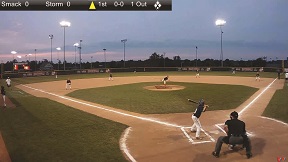
Live video delivered over the Internet sure has come a long way. The 8U athletes of today will never understand the excruciating experience of sitting in front of a desk-sized computer monitor to watch a sport that wasn’t quite popular enough to attract a TV broadcast. Like the leather helmet and the wooden racquet, the days of streaming video with buffering, blue screens and headaches are an endangered species.
Advances in technology have led to more reliable, less expensive and higher-quality streaming solutions and subsequently, have opened the door to new opportunities, particularly in the world of travel sports. We are entering into an era of unprecedented video coverage that presents athletes, fans and scouts with an incredible new medium to follow competitions all over the globe. Equally important, live streaming also presents a significant new revenue stream for tournament organizers and sports complex owners.

In 1995, RealNetworks made history by broadcasting a game between the Seattle Mariners and the New York Yankees over the Internet. Looking back at the quality of that first stream, it was hard to tell if it was Wade Boggs or a Sasquatch in the batter’s box. It would be fair to compare 1995 to the black and white era of television. The picture quality was lacking and there was a very small selection of events to watch. Fast-forward 19 years and streaming video has caught up with TV in picture quality and passed TV in variety. Hop on JustinTV or Ustream and you’ll see anything from Hawaiian news to Georgia dirt bike racing, all in crystal clear high definition.
This past year, did you enjoy any of the live streaming coverage of the 2014 Winter Olympics, a match from the Wimbledon tennis tournament or a few holes of the Masters? These are all examples of national networks using streaming as an extension of their existing coverage in order to reach audiences without access to the traditional networks. They recognize that significant portions of their potential audience can’t be in front of a TV for their biggest events for reasons such as being at work or living overseas.
Streaming over the Internet is the perfect medium to reach those would-be viewers. The technology is here for every tournament director and sports complex owner to look at the potential audience of their competitions the same way the national networks do. Through live streaming, every non-attending fan can join in on the action, tapping into an entirely new revenue stream. For new technologies to become mainstream, they really need to benefit all the parties involved. Live streaming is poised to do just that.

Before jumping into monetization, it is important to understand the costs involved. If you’re interested in streaming your events, there are some basic costs and monetization opportunities that will help guide your decisions. First, you need to assess the baseline Internet and logistical requirements to provide a quality viewership experience. The Internet is the backbone of this exciting new service, so a reliable source with ample upload capacity is absolutely critical. HD-quality streams require a minimum upload capacity of 1.5 mpbs to deliver an HD-quality picture. For example, to live stream five volleyball matches at the same time would require 7.5 mbps of bandwidth. Relatively inexpensive equipment is now available to suit outdoor fields so if the Internet source is strong, virtually any sport can be streamed. Call the local Internet providers at the venue of your events to see what options are available.
Reliable Internet is simply a qualifier to be able to stream. With that in place, the next step to reaching this previously unreachable audience is to consider the nature of your sport and what it will take to capture the action. There are a variety of options to streaming any given event, so be prepared to weigh the costs and effort with the quality of footage and potential revenue of each option.
 In some sports, the majority of the action takes places in a relatively small space, such as volleyball, boxing and gymnastics. In these circumstances, one camera can provide the only vantage point your audience needs to enjoy the game, match or bout. Sports that are played over large fields such as football, soccer and lacrosse aren’t as easily captured and two camera feeds at a minimum may be necessary to provide an enjoyable viewer experience.
In some sports, the majority of the action takes places in a relatively small space, such as volleyball, boxing and gymnastics. In these circumstances, one camera can provide the only vantage point your audience needs to enjoy the game, match or bout. Sports that are played over large fields such as football, soccer and lacrosse aren’t as easily captured and two camera feeds at a minimum may be necessary to provide an enjoyable viewer experience.
The great news is that camera technology has improved tremendously over the last decade while the cost continues to drop. Guidelines regarding leasing the equipment or owning it outright will be covered later on, but as a rule of thumb, the camera system needed for each individual live feed starts at roughly $650 and goes up from there as sophistication increases.
Understanding the monetization side of live-streaming your event is just as important as understanding the expenses. First, consider your potential audience, starting with the vested viewers who are the most engaged with your event. For example, if you are hosting a 50-team baseball tournament, how many busy parents, out of state grandparents, aunts and uncles would absolutely love the chance to see their loved one compete? Every tournament has this core vested audience, no matter the sport.
A potential audience consisting strictly of vested viewers, such as an 8U baseball tournament, is well suited for pay-per-view live streaming. In this situation, there is a dollar amount attached to every single potential viewer out there, no different from gate receipts or concession stand sales. Events with higher stakes and more elite competitors, such as a state championship volleyball tournament, can present the opportunity for sponsorship and advertising revenues. Everything in between can incorporate both forms of monetization. Understanding your audience will help guide you to the streaming solution best suited to monetize the potential viewership.
Once you have the information in hand to weigh the Internet and equipment needs against the potential audience, a fairly clear streaming strategy should emerge. All of this vital information is certainly outside the normal duties of a tournament director or even facility owner/operator, but any live streaming company with solid experience in the youth sports world should be able to help you fill in the blanks.
 Cost Constraints vs. Revenue Opportunity
Cost Constraints vs. Revenue Opportunity
To illustrate some general guidelines, let’s say an event organizer is hosting a high-stakes regional volleyball tournament with 50 temporary courts set up in a convention center. Coverage of every match would require a minimum of 75mbps upload capacity and 50 streaming stations which poses several logistical as well as economic hurdles. This can certainly be done, but another option would be to designate several “championship courts” and equip them for streaming. Equipping five to 10 courts is much less expensive, especially considering the temporary nature, while retaining appeal with the potential audience of the event.
Sports complexes have the luxury of a second option called volume production. Hosting multiple tournaments at the same venue opens the door for highly sophisticated permanent streaming solutions. Permanent solutions are available that capture excellent, universal video footage of entire tournaments, while providing a new year-round revenue stream. Customization has been the biggest advance in this area. Solutions can be designed specifically to suit your complex. Choose from ESPN-level productions to unmanned camera systems that fit fairly seamlessly with current complex operations.
Sports complexes can utilize the “championship” scenario as well, whether that be a single court/field or an entire tournament. Streaming-capable videographers are a Google search away from your location and can provide excellent coverage of the championship caliber tournaments.
Limitless Possibilities
The perpetual advances in software and camera technology paint even more exciting possibilities. We are not far off from a world where affordable cameras follow the action of Little League Baseball as eloquently as today’s coverage of the World Series, and a world where highlights of all aspiring youth competitors are as accessible as finding their profile on Facebook. The organizers of youth sports around the country are in position to, and will be the main beneficiaries of, ushering in this unprecedented era of quality video coverage. But why wait? The technology to profitably provide this fun, cutting-edge service is available today.

